-
Posts
2,616 -
Joined
-
Last visited
Content Type
Profiles
Forums
Store
Help Articles
Posts posted by Peter the eater
-
-
Flank steak is one of my favorite cuts. Its not very popular in my community but still it remains overpriced at $6 or $7/lb - I suppose it has something to do with the fact there's not much flank steak in a given cow.
The odd time flank shows up on the shelf it has a sticker on the package calling it a simmering steak and describing how to marinate it. I have never seen one that's been pre-jacquarded.
I really like the chew, as long as it's cut thin across the grain I find the beefiness hard to beat. Olive oil rub, black pepper, coarse salt:
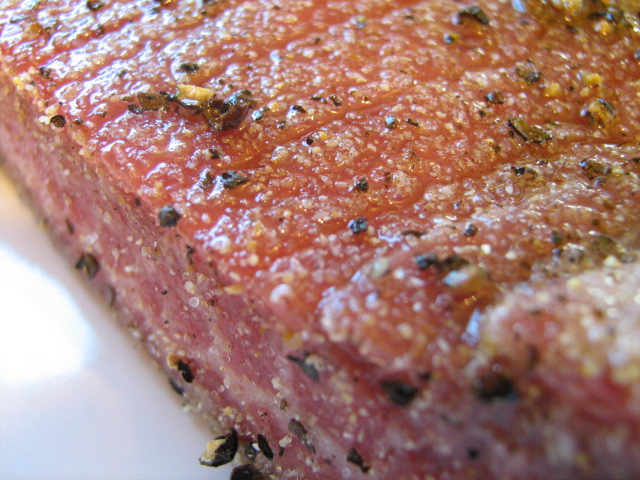
Then its gas grill until crunchy outside and rare inside.
So to answer the question (I get a little excited when there's talk of flank steak) I don't think its necessarily an example of the dumbing down of our commercial food. The retailer probably just wants to make it a bit more foolproof for the general consumer, I can understand that. But since added processing usually means added price and in this case diminished quality, I think I'll pass on mechanically tenderized flank steak.
I didn't know Ralph's is a Kroger store - I've liked Ralph's the odd time I've been.
-
Very nice job David Ross, I am not at all surprised, and I appreciate your additional comments.
We did something similar this past weekend:
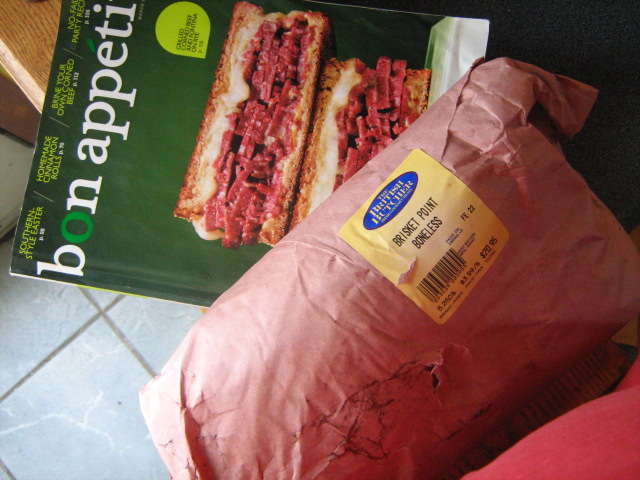
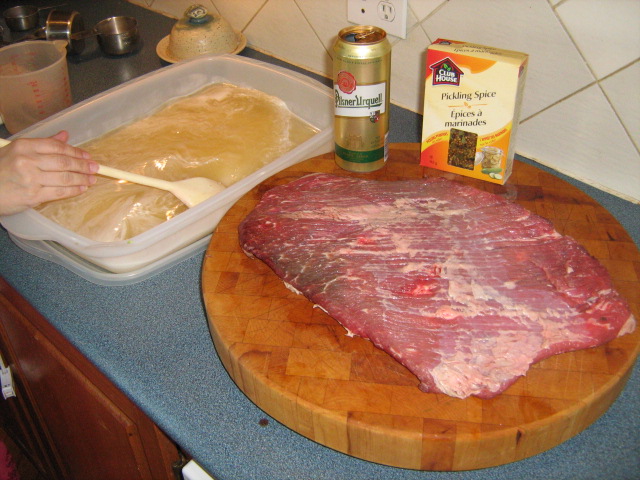
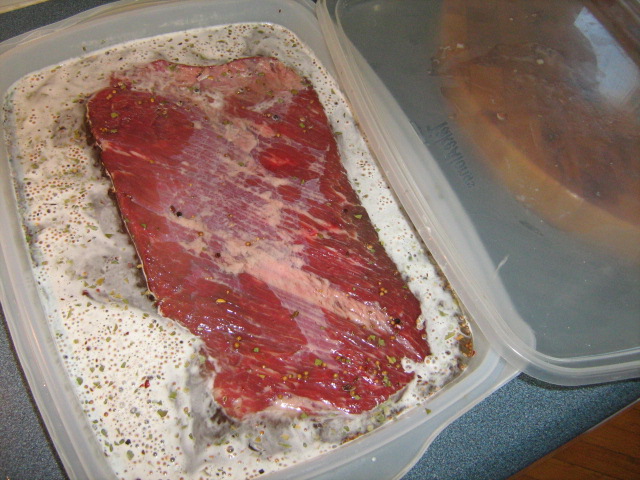
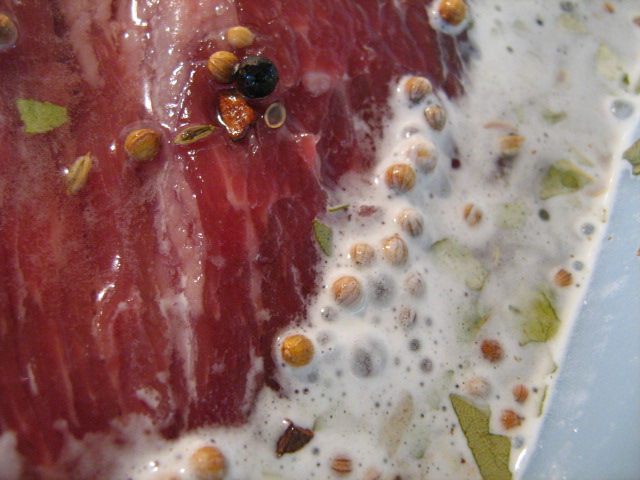
We did not add any nitrate so I'm keen to see the final color of the beef.
-
Some good advice already - I'll add use your fingers. If I get distracted or forget the anatomy while cutting, I just get in there and feel around. Breast meat can be separated quite easily from the bone or cartilage with some finger pressure.
Since you are going for the bone-in breast it shouldn't be too tricky - go with the cleaver or shears.
Is it a butterball?
-
Peter, thank you, again, for a wonderful travelogue.
I feel they are truly among the best stuff here on eGullet.
I doubt that I will ever get to Bogota, but thanks to your pictures and great writing I've learned some things about it! Thank you and please never stop travelling, taking pictures, eating and reporting

That's it exactly, what Klary said.
I look forward to more Peter Green: No Reservations!

-
I haven't been thrilled with any of the whole wheat pasta I've tried. Any recommendations for a good brand of dried whole-wheat pasta? If I can find it at the local grocery store, great -- but not necessary.
I find that the President's Choice Blue Menu whole wheat pastas aren't too bad. At least they are no worse than the rest but are often priced attractively, and they come in lots of crazy shapes that I can't pronounce properly.
I have come to realize that if one wants pasta plus the benefits of a whole grain then they are better off putting that good stuff in the sauce or in the accompanying bread.
-
As usual, a pleasure to read.
I wish I had a seven-foot folk art Lanny Macdonald.
-
Around here, the word sweetbreads refers to the pancreas or thymus gland. They come in lamb and calf (never cow or sheep) and both are affordable delicacies in my book.
Butchers and cooks don't seem to differentiate between the two organs I suppose because they are so similar from a culinary point of view. I wonder about adult wild game - surely they have and use a pancreas, but does the thymus shrink?
-
I think spatchcocking is more attractive than frogging. The later looks like conjoined chickens.
That's it!
I could never quite put my finger on it, now I realize the frogged birds look like something from a veterinarian's manual showing how to separate Siamese twin chickens.

I bought six fresh two-pounders last week and have been preparing each one differently. I still have two to go - I should have been taking pictures. I like to snip the back out with shears, pare out the hips and then separate by removing the breastbone and cutting through the skin. The two haves can be curled up into a poultry pyramid - very attractive.
Another way I tried was to remove all the skin intact and then remove the entire skeleton. I laid out the meat on the skin, seasoned it and then rolled it up into a log. Pretty labor-intensive for an under one kilogram bird, so I think I'll reserve that technique for turkeys.
So now I have a spin-off question: What does one call these techniques? So far we have spatchcock, frog and poultry pyramid (although I just made that last one up).
-
I agree that grit from a can of clams in not acceptable.
With fresh littlenecks (or any other size) I typically find very little grit if any - unlike the steamers. Either way, a soak with a bit of cornmeal seems to get them clean from entrance to exit.
I've heard that the bivalves which are grown at an aquaculture facility are less likely to be gritty - like they don't need to dig in the sand to feed themselves, they just attach to a vertical substrate and live above the seabed. I'm not sure if thats totally accurate, but I do know that the soak has helped me get the grains out prior to cooking..
-
I have often wondered if today's extra large eggs would simply have been called large a few decades ago. Others I've discussed this with have agreed - maybe it's a part of your egg conspiracy. I don't have any data to substantiate this claim, and I know as people get bigger/older everything looks smaller than before - but still - I could swear those eggs of my childhood were larger.
BTW I agree that the public library is a tremendous source for quality cookbooks. I often grab a pile and then maybe one in twenty will I go out and purchase. I figure it has saved me thousands of dollars over the years and a lot of valuable shelf space at home. They may not have the latest releases right away but this acts like a filter - only market-tested good cookbooks get to the library's collections.
-
So guys, are you feeding your partner's libido as well as their belly?
Hell yes.
But it's a two-way street. I am lucky to have a spouse who's a gifted baker and just plain excels in the farinaceous arts. I'm more interested in unusual ingredients and tasty creatures so it's fair to say our house is divided right down the sweet versus savory line. Its a win-win situation.
I think anyone who cooks with passion is sexy. Even the farmers that make the ingredients can be sexy if they are passionate about it.
-
Does this sound okay or do I have my textures wrong? Am I right to classify asparagus as bitter?
I think it sounds like a wonderful combo and that all those adjectives can be achieved with the ingredients listed. I don' think of asparagus as bitter, at least not when I cook it. Unless I've got just the tips or some extremely slender spears I would take a peeler to the stalks.
-
Good discussion - I recently came across some interesting words about bitters on Chicago Chef Laurent Gras's L.2O blog: click.
(the entry is dated January 18, 2008 at the bottom of the page)
The recommendation here is to get some bitters recipes and to start simple. Herbs and citrus dissolved in alcohol can add tremendous interest and dimension to a drink.
What I want to know is where does one get recipes for bitters to make at home?
-
I wanted to bump this thread back up in the hopes that dining in the region has continued its upswing, and that perhaps there are some eGullet forum denizens with updated recommendations.
Well I can't help but I do look forward to a response, I haven't been to West Lafayette in many years. I actually married a boilermaker (M.Sc.'95). When I visited from Toronto (only a 10 hour drive, including a stop at the Dan Quayle Museum in Huntington, IN) we would typically make corn for dinner then go out for beer and/or a sporty event. I can say I have actually dined at the XXX. All I remember on campus is the ice cream places and good coffee spots. I'll bet there are a lot more options now.
-
My pizza joint doesn't deliver.
Fortunately, they are only a few hundred metres away. The idea is for people to call in orders on the way home from work. It has become very popular since opening a year or so ago. We don't have the urban benefits of density and choice but I don't mind since our local pizza is quite good for what it is. When they first opened I told him the sauce was a little on the sweet side. Never tell an Italian-born pizza maker that his sauce is a little on the sweet side.
-
Btw, what are those 'artificial' casings you talk of made of?
If I may butt in . . . I use artificial sausage casings made from collagen. They're really easy to store and use, plus you can choose to eat them or not. There are several other synthetic casings out there, I'd guess cellulose is the next most common (and it's a vegetarian option). There are also some non-edible plastic casings that are really just disposable cylindrical storage units.
-
Do it!
Getting some copper cookware is a bit like getting a microwave or a serious chef's knife - once you get it you can't go without.
A couple of years ago I got a twelve piece set from Ruffoni and they are fantastic. They were second hand but never used and priced at a fraction of the MSRP or what you'd find in the Williams-Sonoma catalog (otherwise I wouldn't have them). A full set is not really necessary, I'd go with a small saucepan for starters. The big stockpot and the paella dish are a bit hard to handle because they are so heavy, at least they have two handles.
I like copper because it is so extremely responsive to heat and because it looks so damn good in the kitchen. But there are many times when a non-stick skillet, iron pan or aluminum pot is simply a better choice for the job. My set has a tin lining which is fine but it is easily gouged with a metal tool. All things being equal, I'd go with a stainless steel lining.
-
You'd want an attenuation button in a kitchen scale?
Sure.
If it means I can weigh objects that are orders of magnitude apart without compromising accuracy then why not. One scale to measure out 1g of salt or 10 kg of potatoes to three significant figures.
I think the digital scale I mentioned had more than one gizmo inside - like small, medium and large. I'm sure it was still an analytical scale meaning it is essentially a balance beam inside, but with more than one size of "constant force" applied to the beam. It was a long time ago but I'll see if I can find a model or a make.
So getting back to the original question, I'd want a dream scale for the kitchen to handle a few grams of powder up to a big 50lb bucket of potatoes.
-
Fascinating. Olive curing is definitely going on my to-do list.
A couple of questions or the experts: does fruit size affect flavor? what are the pros/cons of storing a cured oil in oil?
-
-
I have a real weakness for Diana sauce.
-
What can my dream scale do? What a question!
I use three scales: there's a small digital one for tiny weights like grams and milligrams, a spring-style scale for things that are up to several pounds, and then we have a an old beam scale from a hospital which is obviously best for whole human-sized weights. I don't plan on buying a new scale, but if there was a three-in-one for me I'd consider it.
My understanding is that the first two scales (load sensor and spring) measure force but the beam compares masses, meaning it will work on the moon without calibration. I can't image that's much of a selling feature. Years ago I had a summer job in a pharmaceutical lab and we had scales with an "attenuation button" that allowed the user to switch weighing zones by a factor of ten. This means you could maintain super accuracy whether the object was one, ten, a hundred or a thousand grams.
My dream scale has an attenuation button.
-
I saw green unprocessed rock-hard olives in my grocery store a few years ago. Naturally I bought a few for research purposes and took them home. I tried to eat a few as is - highly unpalatable is a big understatement. So why are they sold this way? That's the question I'd like answered given I am not dead. Are people pressing their own oil? Do folks cure them at home?
-
Clearly, I dont have a problem with the word.
But for those of you who do, William Kitchiner in The Cook's Oracle (1817) used the word Mouthician.
I've never seen the word used anywhere else, and the OED does not include it, so it must have been WK's own.
Thank you Janet, I was hoping for your always well-researched input. I hope you weren't alarmed by the topic title.
I like mouthician, although it makes me think of a dentist . . . or worse.



Picnic Places in Paris
in France: Cooking & Baking
Posted
Its been two and a half years since Carlsbad asked the question but it's still very interesting to read what the locals, semi-locals and tourists say about picnicking in Paris.
I haven't been in a while but plan to go back next Spring. I spent a summer living downtown years ago and the picnics were very frequent. The worst place I recall was the parc at the Centre Georges Pompidou at Beaubourg. The best destination places (where an actual picnic blanket was used) were the grounds at Versailles and the Bois de Boulogne.